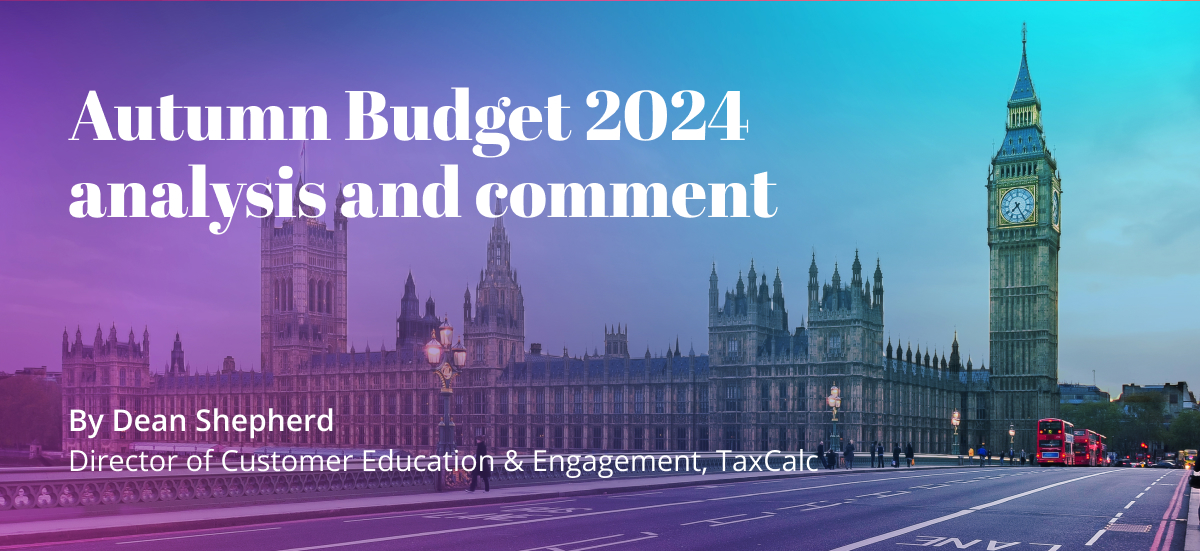TaxCalc Blog
News and events from TaxCalc
Autumn Budget 2024 analysis and comment

An end to austerity or a new era of “painful” tax rises?
In the most anticipated budget for a generation, Rachel Reeves – chess prodigy, Oxbridge graduate and former Bank of England economist – is well qualified to deliver Labour’s first budget for 14 years. As the UK’s first female Chancellor of the Exchequer, she will undoubtedly continue to inspire the next generation of female economists and political leaders but has her budget delivered on the promise to protect working people, fix the NHS and rebuild Britain?
Don’t worry if you missed the live delivery, all the key changes and announcements are summarised below but if that is not enough to satisfy your craving for budget coverage, then why not join us in the TaxCalc studios for our detailed budget analysis.
Autumn budget 2024 takeaways
Employer National Insurance Contributions changes
There are a number of changes to Employer National Insurance Contributions (NICs), including:
- Reducing the Secondary Threshold (ST) from £9,100 annual equivalent to £5,000 annual equivalent, then increasing it in line with CPI from 2028-29.
- Increasing the Employer NICs (ER NICs) rate from 13.8% to 15% (over the ST).
- Increasing the Employment Allowance (EA) from £5,000 to £10,500.
- Removing the Employment Allowance cap, meaning employers with ER NIC liabilities over £100,000 in the previous tax year (but which are otherwise eligible) are able to claim the full £10,500 Employment Allowance.
These measures will be effective from 6th April 2025
Capital Gains Tax changes
There will be an increase to the Capital Gains Tax (CGT) main rates from 10% to 18% and from 20% to 24% for the lower and higher rate respectively, to be aligned with the existing rates on residential property.
This measure will be effective from budget day, 30 October 2024.
The Business Asset Disposal Relief (BADR) and Investors’ Relief (IR) rate will increase from 10% to 14% from 6 April 2025 and to 18% from 6 April 2026.
Inheritance Tax changes
In addition to existing nil-rate bands and exemptions, the current 100% rates of Agricultural Property Relief (APR) and Business Property Relief (BPR) will continue for the first £1 million of combined agricultural and business property. The rate of relief will be 50% thereafter, and in all circumstances for shares designated as “not listed” on the markets of recognised stock exchanges, such as the Alternative Investment Market (AIM).
This measure will be effective from 6 April 2026.
Unused pension funds and death benefits payable from a pension will be brought into a person’s estate for Inheritance Tax (IHT) purposes.
This measure will be effective from 6 April 2027.
The Nil-Rate Band and Residence Nil-Rate Band thresholds will be fixed at £325,000 and £175,000 respectively for tax years 2028-29 and 2029-30. The Residence Nil-Rate Band taper will also be fixed at the current level of £2 million.
Mandatory registration of tax practitioners interacting with HMRC
This measure will invest to modernise HMRC’s tax adviser registration services and will mandate registration of tax advisers who interact with HMRC on behalf of clients.
Registration will be mandatory from April 2026
Changes affecting private school education
The standard rate of VAT (20%) will apply to education and boarding services provided by private schools from 1 January 2025.
Eligibility of private schools for charitable business rate relief will be removed from 1 April 2025.
Changes affecting non-domiciled individuals
The remittance basis of taxation for non-UK domiciled individuals is being abolished and replaced with a simpler residence-based regime. Individuals opting into the regime will not pay UK tax on foreign income and gains (FIG) for the first four years of tax residence, provided they have been non-tax resident for the previous 10 years.
This measure introduces a residence-based system for Inheritance Tax and the planned 50% reduction in foreign income subject to tax in the first year will be scrapped. For Capital Gains Tax purposes, current and past remittance basis users will be able to rebase personally held foreign assets to 5 April 2017 on disposal where certain conditions are met.
Overseas Workday Relief will be extended to a four-year period and will be subject to an annual financial limit of the lower of £300,000 or 30% of net employment income. This measure also extends the previously announced Temporary Repatriation Facility to three years and expands the scope to trust structures.
This measure will be effective from 6 April 2025.
Stamp Duty Land Tax changes
There will be an increase to the Higher Rates for Additional Dwellings surcharge on Stamp Duty Land Tax (SDLT) from 3% to 5%. It will also increase the single rate of SDLT that is charged on the purchase of dwellings costing more than £500,000 by corporate bodies from 15% to 17%.
This measure will be effective from 31 October 2024.
Increasing the interest rate on unpaid tax
The government will increase the late payment interest rate charged by HMRC on unpaid tax liabilities by 1.5% to Bank Rate plus 4%.
This measure will be effective from 6 April 2025.
Tax on company cars
Fully electric and zero emission vehicle rates will increase by 2% per annum across 2028-29 and 2029-30. Rates for cars with emissions of 1-50g/km of CO2 will increase to 18% in 2028-29 and 19% in 2029-30. Rates for all other emission bands will increase by 1% per annum to maximum of 38% for 2028-29 and 39% for 2029-30.
Van Benefit Charge will increase in line with September 2024 CPI growth.
Amending anti-avoidance rules for close company shareholders
Section 455 ‘Loans to Participators’ legislation will be amended to prevent close companies recycling loans through two or more companies to avoid tax.
This measure will be effective from 30 October 2024.
Changes to tax rules on liquidations of Limited Liability Partnerships
Where a member of a Limited Liability Partnership (LLP) has contributed assets to an LLP, chargeable gains that accrue up to the contribution are taxed (either Capital Gains Tax or Corporation Tax) when the LLP is liquidated and the assets are disposed of to the member, or to a person connected to them. The LLP will be liable in the normal way for gains from the time of contribution on their actual disposal of the asset.
This measure will be effective from 30 October 2024.
Strengthen existing charity tax rules from April 2026
Several changes to legislation to aid compliance with charitable tax reliefs include:
- Tainted Donations: To strengthen HMRC compliance powers to take action when a donor gives to a charity with the intention of receiving an advantage back.
- Approved Investments: To make it explicit that all investments by charities that qualify for charitable tax reliefs must be for the benefit of the charity and not the avoidance of tax.
- Attributable Income: To extend the existing rule that charities’ tax relieved income must be spent on charitable activities to income received from legacies.
These measures will be effective from April 2026.
Business rates
40% business rates discount available to businesses occupying eligible retail, hospitality and leisure properties in England, up to a cash cap of £110,000 per business for one year.
The small business multiplier will be frozen at 49.9p for 12 months.
These measures will be effective from 1 April 2025.
Other announcements
Other key announcements that may be of relevance to your clients were as follows:
- Subscription limits for Adult ISAs, Junior ISAs and Child Trust Funds will be maintained
- 100% first-year allowances for zero-emission cars and electric vehicle charge-points extended to 31 March 2026 for Corporation Tax and 5 April 2026 for Income Tax
- Changes to tax rules on alternative finance arrangements from 30 October 2024
- Increase in the Carer’s Allowance earnings limit to the equivalent of 16 hours at the National Living Wage from April 2025
- Extension of employer NICs relief for hiring veterans for one year from 6 April 2025
- The Starting Rate for Savings (SRS) will be maintained at £5,000 for 2025-26
- Measures to make recruitment agencies responsible for accounting for PAYE on payments made to workers that are supplied via umbrella companies from April 2026
- Confirmation of the payrolling of employment benefits from April 2026
- HMRC to recruit 5,000 additional compliance staff by 2029-30
- HMRC to recruit 1,800 additional debt management staff
Autumn Budget 2024. Expert Analysis with Sharon Cooke.
As with any Budget, the real impact lies in the details. Our technical experts are delving deep to uncover what these changes mean for you and your clients.
Join us along with our special guest Sharon Cooke, Technical Director at 20:20 Innovation, for an in-depth review and analysis of the key announcements in our upcoming webinar.





